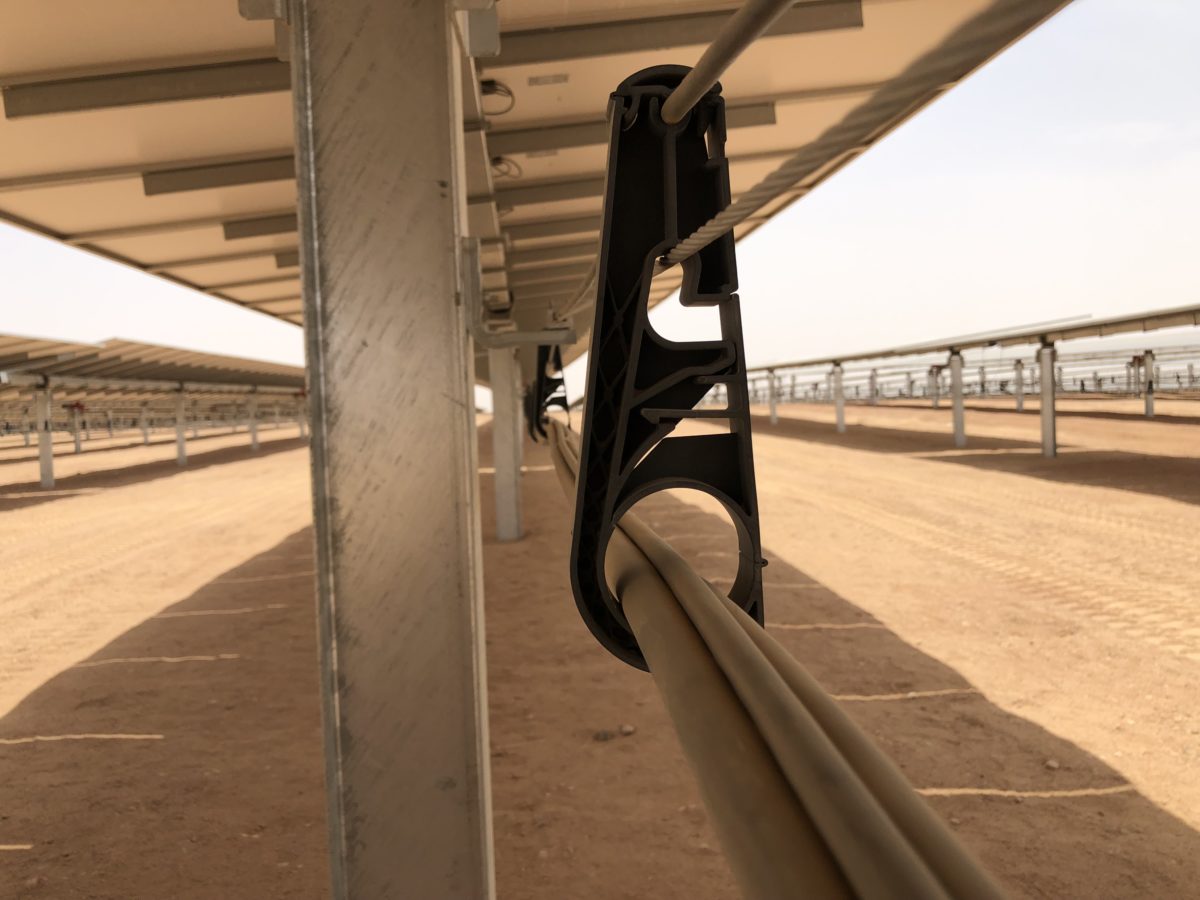In a unique circumstance, an engineering, procurement, and construction (EPC) service provider had approached Fränkische Cable Management AG (FCM AG), a manufacturer of cable management equipment, with some challenges that they were experiencing with steel cable hanging solutions. The EPC said that steel cable hangers are quite expensive and a bit archaic. FCM AG built a specialized plastic cable hanging solution to meet the solar developer's needs.
“The new cable holder is just a small part of the overall solar plant installation,” says Jonny Billeter, managing director of FCM AG. “However, it is of relevant significance for reliable operation of the energy plant, offering an essential cost saving potential.”
As photovoltaics has stepped out of its cradle and matured into a competitive market player, a couple of things have carved out distinct effects on the market. First, the race to the bottom for the lowest levelized cost of energy has become seriously cut-throat. Tenders awarded at just over $0.02/kWh hardly manage to raise eyebrows anymore, as both the U.S. and Brazil have claimed to break the magic two cents barrier. With prices in a tumble, marginal gains here and there could eventually win or lose a tender round.
When systems are not refinanced using fixed tariffs in tenders, they are likely developed outside of subsidy schemes under power purchase agreements (PPAs). Here a new challenge arises. With fixed rate government subsidies, payback times are in the ten years margin. However, PPA-backed solar parks must run smoothly, producing for 20 to 30 years to foot the bill and bring in the profit. The subsidy free calculation only squares if there are no breakages and downtime. Reliability has become a paramount issue, more than ever before.
The EPC approaching FCM AG was challenged by the steel cable holders have a design limitation that cannot be fixed. Steel, compared to plastic, is a rather heavy material. The plastic hangers weigh in at just 200g per piece, which allows workers in the field to carry around 50 pieces per ‘run.’ Thanks to the reduced weight and hang-in design of the FCM AG plastic alternative, installation costs associated with cable hanger installation can be reduced by around 35%, according to the company.
FCM AG has 200,000 installed pieces of this new type of plastic cable fixings at a slice of the Benban Solar complex, a system comprised of 300,000 solar modules in Egypt. The cable holder with a recommended mounting distance from approximately 1000mm to 1500mm is easy to carry along the cable lines and to install at regular intervals.
More from our partners
This marginal advantage begins to materialize into a reduction on installation costs. The reduced weight also means that shipping and on-site transportation of the equipment comes in at a lower price point.
Another important aspect is that the FCM AG Cable Holder ensures a fixed distance between the data- and the power/trunk cables of 150mm to prevent mutual interference. Maintaining a distance between the power cable and data connection can become more important than one would initially think. Cables running along the tables, and connecting strings, emit a significant electromagnetic field. If a data cable for plant monitoring and optimization is laid within the immediate vicinity of the power cable, the inductivity can disturb the signal and lead to false or interrupted data transmission.
In addition to savings created by the easy clip-in design and, the use of plastic offers another range of advantages to help ensure a failure-free plant operation over a 20 year or longer lifetime. Not only will the hangers themselves last over a longer period, thanks to the modern polyamide compound PA6/PA66, but the cables themselves experience reduced risk of rubbing against sheer metal. The rubbing of the cables’ plastic cover against metal hangers can, under some circumstances, prematurely wear off the plastic housing of the cable; a process that is likely to happen at a much slower rate if the plastic housings rub against plastic hangers.
This innovative solution provides a high-grade weathering resistance and UV stability of up to 30 years. The quick and easy installation of the universally suitable product, its low weight, and corrosion resistance in sea-shore areas, are convincing aspects for the future of the cable holder.
For more information, contact info.cable@fraenkische-ch.com.
This content is protected by copyright and may not be reused. If you want to cooperate with us and would like to reuse some of our content, please contact: editors@pv-magazine.com.



By submitting this form you agree to pv magazine using your data for the purposes of publishing your comment.
Your personal data will only be disclosed or otherwise transmitted to third parties for the purposes of spam filtering or if this is necessary for technical maintenance of the website. Any other transfer to third parties will not take place unless this is justified on the basis of applicable data protection regulations or if pv magazine is legally obliged to do so.
You may revoke this consent at any time with effect for the future, in which case your personal data will be deleted immediately. Otherwise, your data will be deleted if pv magazine has processed your request or the purpose of data storage is fulfilled.
Further information on data privacy can be found in our Data Protection Policy.